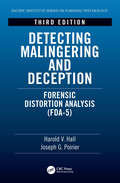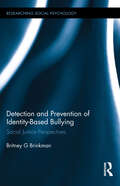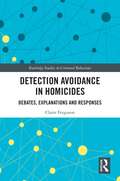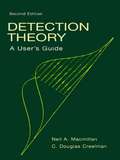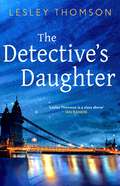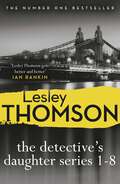- Table View
- List View
Destructiveness, Intersubjectivity and Trauma: The Identity Crisis of Modern Psychoanalysis
by Werner Bohleber'At last we have a book that provides a comprehensive overview and assessment of the intersubjective turn in psychoanalysis, showing its logical and clinical limitations and exploring its social and cultural determinants. Bohleber emphasizes the clinical importance of real traumatic experience along with the analysis of the transference as he reviews and broadens psychoanalytic theories of memory in relation to advances in cognitive psychology and neuroscience. Psychoanalytic ideas on personality, adolescence and identity are re-thought and updated. Bohleber brilliantly presents a unique understanding of malignant narcissism and prejudice in relation to European anti-Semitism and to contemporary religiously inspired terrorist violence.'- Cyril Levitt, Dr Phil, Professor and former Chair Department of Sociology, McMaster University Hamilton, Ontario. Psychoanalyst in private practice, Toronto, Ontario
Destructiveness, Intersubjectivity and Trauma: The Identity Crisis of Modern Psychoanalysis (The\developments In Psychoanalysis Ser.)
by Werner Bohleber'At last we have a book that provides a comprehensive overview and assessment of the intersubjective turn in psychoanalysis, showing its logical and clinical limitations and exploring its social and cultural determinants. Bohleber emphasizes the clinical importance of real traumatic experience along with the analysis of the transference as he reviews and broadens psychoanalytic theories of memory in relation to advances in cognitive psychology and neuroscience. Psychoanalytic ideas on personality, adolescence and identity are re-thought and updated. Bohleber brilliantly presents a unique understanding of malignant narcissism and prejudice in relation to European anti-Semitism and to contemporary religiously inspired terrorist violence.'- Cyril Levitt, Dr Phil, Professor and former Chair Department of Sociology, McMaster University Hamilton, Ontario. Psychoanalyst in private practice, Toronto, Ontario
Detecting Concealed Information and Deception: Recent Developments
by J. Peter RosenfeldDetecting Concealed Information and Deception: Recent Developments assembles contributions from the world's leading experts on all aspects of concealed information detection. This reference examines an array of different methods—behavioral, verbal interview and physiological—of detecting concealed information. Chapters from leading legal authorities address how to make use of detected information for present and future legal purposes. With a theoretical and empirical foundation, the book also covers new human interviewing techniques, including the highly influential Implicit Association Test among others. - Presents research from Concealed Information Test (CIT) studies - Explores the legal implications and admissibility of the CIT - Covers EEG, event-related brain potentials (ERP) and autonomic detection measures - Reviews multiple verbal lie detection tools - Discusses ocular movements during deception and evasion - Identifies how to perceive malicious intentions - Explores personality dimensions associated with deception, including religion, age and gender
Detecting Deception: Current Challenges and Cognitive Approaches (Wiley Series in Psychology of Crime, Policing and Law)
by Pär Anders Granhag Aldert Vrij Bruno VerschuereDetecting Deception offers a state-of-the-art guide to the detection of deception with a focus on the ways in which new cognitive psychology-based approaches can improve practice and results in the field. Includes comprehensive coverage of the latest scientific developments in the detection of deception and their implications for real-world practice Examines current challenges in the field - such as counter-interrogation strategies, lying networks, cross-cultural deception, and discriminating between true and false intentions Reveals a host of new approaches based on cognitive psychology with the potential to improve practice and results, including the strategic use of evidence, imposing cognitive load, response times, and covert lie detection Features contributions from internationally renowned experts
Detecting Deception: Current Challenges and Cognitive Approaches (Wiley Series in Psychology of Crime, Policing and Law)
by Pär Anders Granhag Aldert Vrij Bruno VerschuereDetecting Deception offers a state-of-the-art guide to the detection of deception with a focus on the ways in which new cognitive psychology-based approaches can improve practice and results in the field. Includes comprehensive coverage of the latest scientific developments in the detection of deception and their implications for real-world practice Examines current challenges in the field - such as counter-interrogation strategies, lying networks, cross-cultural deception, and discriminating between true and false intentions Reveals a host of new approaches based on cognitive psychology with the potential to improve practice and results, including the strategic use of evidence, imposing cognitive load, response times, and covert lie detection Features contributions from internationally renowned experts
Detecting Lies and Deceit: Pitfalls and Opportunities (Wiley Series in Psychology of Crime, Policing and Law #55)
by Aldert VrijWhy do people lie? Do gender and personality differences affect how people lie? How can lies be detected? Detecting Lies and Deceit provides the most comprehensive review of deception to date. This revised edition provides an up-to-date account of deception research and discusses the working and efficacy of the most commonly used lie detection tools, including: Behaviour Analysis Interview Statement Validity Assessment Reality Monitoring Scientific Content Analysis Several different polygraph tests Voice Stress Analysis Thermal Imaging EEG-P300 Functional Magnetic Resonance Imaging (fMRI) All three aspects of deception are covered: nonverbal cues, speech and written statement analysis and (neuro)physiological responses. The most common errors in lie detection are discussed and practical guidelines are provided to help professionals improve their lie detection skills. Detecting Lies and Deceit is a must-have resource for students, academics and professionals in psychology, criminology, policing and law.
Detecting Lies and Deceit: Pitfalls and Opportunities (Wiley Series in Psychology of Crime, Policing and Law)
by Aldert VrijWhy do people lie? Do gender and personality differences affect how people lie? How can lies be detected? Detecting Lies and Deceit provides the most comprehensive review of deception to date. This revised edition provides an up-to-date account of deception research and discusses the working and efficacy of the most commonly used lie detection tools, including: Behaviour Analysis Interview Statement Validity Assessment Reality Monitoring Scientific Content Analysis Several different polygraph tests Voice Stress Analysis Thermal Imaging EEG-P300 Functional Magnetic Resonance Imaging (fMRI) All three aspects of deception are covered: nonverbal cues, speech and written statement analysis and (neuro)physiological responses. The most common errors in lie detection are discussed and practical guidelines are provided to help professionals improve their lie detection skills. Detecting Lies and Deceit is a must-have resource for students, academics and professionals in psychology, criminology, policing and law.
Detecting Malingering and Deception: Forensic Distortion Analysis (FDA-5) (Pacific Institute Series on Forensic Psychology)
by Harold V. Hall Joseph PoirierDetecting Malingering and Deception: Forensic Distortion Analysis (FDA-5), Third Edition maintains the tradition of the prior two editions, following the Forensic Distortion Analysis (FDA) model. Fully updated since the last edition nearly 20 years ago, the book continues to serve as comprehensive volume on deception and distortion in forensic, clinical and several specialized contexts. As with the previous editions, the book presents a model of deception intended to be utilized and applied by the qualified evaluator. The proposed model covers targets of the faker, response styles show, and methods to detect the deception. The goal is to summarize the historical and latest information on distortion detection, to present guidelines for detecting deception that include variable accuracy rates based on different detection techniques, and to stimulate further research of effective methods of deception detection. Recommendations and guidelines for the practicing clinician are offered throughout the book, including real-world cases to inform and enlighten, particularly in unique cases or those in which the certain outcomes are unexpected. Key Features: Outlines the role of the forensic professional in applying and integrating methods assessment in deception and distortion Provides base-rates for deception-related behavior and events, especially useful in report writing or courtroom testimony as an expert witness Presents the latest advances in methodology and technology to assist in the search for ground truth in applied settings and situations Applies forensic distortion analysis to evaluate the deception-related findings and statements of other professionals involved in a particular case New coverage includes sections and chapters on deception analysis for collectivities, including media groups, contemporary politics, cross-national corporations, conflict, and terrorism Detecting Malingering and Deception incorporates the latest research, providing practical application to utilize information and evaluative methods as they pertain to deception-related settings and situations. Sample reports and extensive graphs, tables, charts, and histograms are provided, and every chapter has been updated with new studies and investigations. The Third Edition boasts six new chapters of coverage to expand the exploration of deception addressing advances in the field, and our current understanding of the phenomenon.
Detecting Malingering and Deception: Forensic Distortion Analysis (FDA-5) (Pacific Institute Series on Forensic Psychology)
by Harold V. Hall Joseph PoirierDetecting Malingering and Deception: Forensic Distortion Analysis (FDA-5), Third Edition maintains the tradition of the prior two editions, following the Forensic Distortion Analysis (FDA) model. Fully updated since the last edition nearly 20 years ago, the book continues to serve as comprehensive volume on deception and distortion in forensic, clinical and several specialized contexts. As with the previous editions, the book presents a model of deception intended to be utilized and applied by the qualified evaluator. The proposed model covers targets of the faker, response styles show, and methods to detect the deception. The goal is to summarize the historical and latest information on distortion detection, to present guidelines for detecting deception that include variable accuracy rates based on different detection techniques, and to stimulate further research of effective methods of deception detection. Recommendations and guidelines for the practicing clinician are offered throughout the book, including real-world cases to inform and enlighten, particularly in unique cases or those in which the certain outcomes are unexpected. Key Features: Outlines the role of the forensic professional in applying and integrating methods assessment in deception and distortion Provides base-rates for deception-related behavior and events, especially useful in report writing or courtroom testimony as an expert witness Presents the latest advances in methodology and technology to assist in the search for ground truth in applied settings and situations Applies forensic distortion analysis to evaluate the deception-related findings and statements of other professionals involved in a particular case New coverage includes sections and chapters on deception analysis for collectivities, including media groups, contemporary politics, cross-national corporations, conflict, and terrorism Detecting Malingering and Deception incorporates the latest research, providing practical application to utilize information and evaluative methods as they pertain to deception-related settings and situations. Sample reports and extensive graphs, tables, charts, and histograms are provided, and every chapter has been updated with new studies and investigations. The Third Edition boasts six new chapters of coverage to expand the exploration of deception addressing advances in the field, and our current understanding of the phenomenon.
Detection and Prevention of Identity-Based Bullying: Social Justice Perspectives (Researching Social Psychology)
by Britney G BrinkmanBullying in schools has become the focus of a growing body of literature; however, much of that work diminishes the role of social context, social identities, and prejudices despite extensive research evidence suggesting that many victims of bullying are targeted because of an aspect of their social identity. This book demonstrates how the prevention and intervention of this phenomenon, termed identity-based bullying, is a social justice issue. Expanding beyond bullying prevention that focuses on individual perpetrators, the book examines identity-based bullying in schools as a microcosm of larger systemic tensions and conflicts. The author utilizes a social constructivist perspective to understand the experiences of children as active agents in their own lives. She also provides an international framework to describe the impact of culture, social structures, and politics from the US and the UK. Challenges and barriers to addressing identity-based bullying are explored and recommendations are made for best practices for teachers, administrators, and mental health professionals to prevent and respond to identity-based bullying.
Detection and Prevention of Identity-Based Bullying: Social Justice Perspectives (Researching Social Psychology)
by Britney G BrinkmanBullying in schools has become the focus of a growing body of literature; however, much of that work diminishes the role of social context, social identities, and prejudices despite extensive research evidence suggesting that many victims of bullying are targeted because of an aspect of their social identity. This book demonstrates how the prevention and intervention of this phenomenon, termed identity-based bullying, is a social justice issue. Expanding beyond bullying prevention that focuses on individual perpetrators, the book examines identity-based bullying in schools as a microcosm of larger systemic tensions and conflicts. The author utilizes a social constructivist perspective to understand the experiences of children as active agents in their own lives. She also provides an international framework to describe the impact of culture, social structures, and politics from the US and the UK. Challenges and barriers to addressing identity-based bullying are explored and recommendations are made for best practices for teachers, administrators, and mental health professionals to prevent and respond to identity-based bullying.
Detection Avoidance in Homicide: Debates, Explanations and Responses (Routledge Studies in Criminal Behaviour)
by Claire FergusonDetection Avoidance in Homicides: Debates, Explanations and Responses presents theory and research on how offenders avoid detection and the challenges and opportunities these efforts pose to investigators. From a scholarly perspective, the book presents a continuing history of research on detection avoidance by offenders, discusses the features of complex death investigations involving detection avoidance, and critiques the current frameworks used for conceptualizing these behaviors. Dr. Ferguson focuses on the key debates in the literature, argues for collaborations between researchers and practitioners to remedy siloing, and explores the reality of detection avoidance in homicides as complex and multifaceted. While detection avoidance behaviors have the potential to negatively impact sudden death investigations and frustrate criminal investigations specifically, their use also creates broader problems. These include many problematic effects on family members of the deceased, police officers, police agencies and the communities they serve. Offenders choosing to use detection avoidance behaviors challenges the efficient use of public resources, puts at risk the successful adjudication of homicides, and creates a public safety issue. The book explains detection avoidance using learning, situational, individual and gender-based theories, including proposing whether it may be a form of coercive control used by intimate partner abusers. Finally, how detection avoidance by offenders is recognized and responded to in sudden death investigations is addressed, with specific reference to useful examples of policy reform implemented by various police agencies internationally. Providing research and theory to explain detection avoidance and best practice for responding to it, this book will be of great interest to students and scholars of criminology, forensic science and psychology. It will also be useful to professionals working with homicide offenders.
Detection Avoidance in Homicide: Debates, Explanations and Responses (Routledge Studies in Criminal Behaviour)
by Claire FergusonDetection Avoidance in Homicides: Debates, Explanations and Responses presents theory and research on how offenders avoid detection and the challenges and opportunities these efforts pose to investigators. From a scholarly perspective, the book presents a continuing history of research on detection avoidance by offenders, discusses the features of complex death investigations involving detection avoidance, and critiques the current frameworks used for conceptualizing these behaviors. Dr. Ferguson focuses on the key debates in the literature, argues for collaborations between researchers and practitioners to remedy siloing, and explores the reality of detection avoidance in homicides as complex and multifaceted. While detection avoidance behaviors have the potential to negatively impact sudden death investigations and frustrate criminal investigations specifically, their use also creates broader problems. These include many problematic effects on family members of the deceased, police officers, police agencies and the communities they serve. Offenders choosing to use detection avoidance behaviors challenges the efficient use of public resources, puts at risk the successful adjudication of homicides, and creates a public safety issue. The book explains detection avoidance using learning, situational, individual and gender-based theories, including proposing whether it may be a form of coercive control used by intimate partner abusers. Finally, how detection avoidance by offenders is recognized and responded to in sudden death investigations is addressed, with specific reference to useful examples of policy reform implemented by various police agencies internationally. Providing research and theory to explain detection avoidance and best practice for responding to it, this book will be of great interest to students and scholars of criminology, forensic science and psychology. It will also be useful to professionals working with homicide offenders.
Detection of Change: Event-Related Potential and fMRI Findings
by JohnPolichThis volume presents the first systematic overview of how event-related brain potential (ERP), cognitive electroencephalography (EEG), and functional magnetic imaging (fMRI) measures reflect the mental events arising from changes in sensory stimulation. The contents are fresh, the literature distillations highly informative, and the range of topics extremely useful for cognitive neuroscientists, psychologists, and researchers.
Detection of Malingering during Head Injury Litigation
by Cecil R. Reynolds and Arthur MacNeill HortonIncreased public awareness of traumatic brain injuries has fueled a number of significant developments: on the one hand, more funding and more research related to these injuries and their resulting deficits; on the other, the possibility of higher stakes in personal injury suits—and more reasons for individuals to feign injury. Expanding both the conceptual and clinical knowledge base on the subject, the Second Edition of Detection of Malingering during Head Injury Litigation offers the latest detection tools and techniques for veteran and novice alike. As in its initial incarnation, this practical revision demonstrates how to combine clinical expertise, carefully-gathered data, and the use of actuarial models as well as common sense in making sound evaluations and reducing ambiguous results. And, the book navigates the reader through the many caveats that come with the job, beginning with the scenario that an individual may be malingering despite having an actual brain injury. Among the updated features: •Specific chapters on malingering on the Halstead-Reitan, Luria-Nebraska, and MMPI-2. •A framework for distinguishing genuine from factitious PTSD in head injury cases. •Detailed information regarding performance on the WMT, MSVT, and NV-MSVT by children with developmental disabilities. •Guidelines for explaining symptom validity testing to the trier of fact. •Entirely new chapters on mild TBI and on malingering of PTSD symptoms in the context of TBI litigation. Professional neuropsychologists and forensic psychologists will appreciate this new edition of Detection of Malingering during Head Injury Litigation as an invaluable source of refinements to their craft, and improvement as an expert witness.
Detection of Malingering during Head Injury Litigation
by Arthur MacNeill Horton Cecil R. ReynoldsExpanding both the conceptual and clinical knowledge base on the subject, the Third Edition of Detection of Malingering during Head Injury Litigation offers the latest detection tools and techniques for veteran and novice alike. Increased public awareness of traumatic brain injuries has fueled a number of significant developments: on the one hand, more funding and more research related to these injuries and their resulting deficits; on the other, the possibility of higher stakes in personal injury suits—and more reasons for individuals to feign injury.As in its earlier editions, this practical revision demonstrates how to combine clinical expertise, carefully-gathered data, and the use of actuarial models as well as common sense in making sound evaluations and reducing ambiguous results. The book navigates the reader through the many caveats that come with the job, beginning with the scenario that an individual may be malingering despite having an actual brain injury. Among the updated features:Specific chapters on malingering on the Word Memory Test (WMT), Test of Malingered Memory (TOMM) MMPI-2, MMPI-RF and MMPI-3;Detailed information regarding performance on performance validity tests in the domain of executive functioning and memory, Guidelines for explaining performance and symptom validity testing to the trier of fact;Chapters on mild TBI in children in head injury litigation, cultural concerns and ethical issues in the context of head injury litigation.
Detection of Malingering during Head Injury Litigation (Critical Issues in Neuropsychology)
by Cecil R. ReynoldsNeuropsychologists and forensic psychologists have long lacked a systematic, scientific means of assessing head injury cases, of distinguishing those plaintiffs whose pain and suffering is real and deserves just compensation from those who are simply faking it. Cecil R. Reynolds and his expert contributors provide the first definitive work on this subject, focusing on problems that beset clinicians who are called upon to evaluate head injuries in civil courts. They describe the major malingering detection techniques currently in use.
The Detection of Nonplanar Surfaces in Visual Space
by W. R. UttalFirst published in 1984. Routledge is an imprint of Taylor & Francis, an informa company.
The Detection of Nonplanar Surfaces in Visual Space
by W. R. UttalFirst published in 1984. Routledge is an imprint of Taylor & Francis, an informa company.
Detection Theory: A User's Guide
by Michael J. Hautus Neil A. Macmillan C. Douglas CreelmanDetection Theory: A User’s Guide is an introduction to one of the most important tools for the analysis of data where choices must be made and performance is not perfect. In these cases, detection theory can transform judgments about subjective experiences, such as perceptions and memories, into quantitative data ready for analysis and modeling. For beginners, the first three chapters introduce measuring detection and discrimination, evaluating decision criteria, and the utility of receiver operating characteristics. Later chapters cover more advanced research paradigms, including: complete tools for application, including flowcharts, tables, and software; student-friendly language; complete coverage of content area, including both one-dimensional and multidimensional models; integrated treatment of threshold and nonparametric approaches; an organized, tutorial level introduction to multidimensional detection theory; and popular discrimination paradigms presented as applications of multidimensional detection theory. This modern summary of signal detection theory is both a self-contained reference work for users and a readable text for graduate students and researchers learning the material either in courses or on their own.
Detection Theory: A User's Guide
by Michael J. Hautus Neil A. Macmillan C. Douglas CreelmanDetection Theory: A User’s Guide is an introduction to one of the most important tools for the analysis of data where choices must be made and performance is not perfect. In these cases, detection theory can transform judgments about subjective experiences, such as perceptions and memories, into quantitative data ready for analysis and modeling. For beginners, the first three chapters introduce measuring detection and discrimination, evaluating decision criteria, and the utility of receiver operating characteristics. Later chapters cover more advanced research paradigms, including: complete tools for application, including flowcharts, tables, and software; student-friendly language; complete coverage of content area, including both one-dimensional and multidimensional models; integrated treatment of threshold and nonparametric approaches; an organized, tutorial level introduction to multidimensional detection theory; and popular discrimination paradigms presented as applications of multidimensional detection theory. This modern summary of signal detection theory is both a self-contained reference work for users and a readable text for graduate students and researchers learning the material either in courses or on their own.
Detection Theory: A User's Guide
by Neil A. Macmillan C. Douglas CreelmanDetection Theory is an introduction to one of the most important tools for analysis of data where choices must be made and performance is not perfect. Originally developed for evaluation of electronic detection, detection theory was adopted by psychologists as a way to understand sensory decision making, then embraced by students of human memory. It has since been utilized in areas as diverse as animal behavior and X-ray diagnosis.This book covers the basic principles of detection theory, with separate initial chapters on measuring detection and evaluating decision criteria. Some other features include:*complete tools for application, including flowcharts, tables, pointers, and software;*student-friendly language;*complete coverage of content area, including both one-dimensional and multidimensional models;*separate, systematic coverage of sensitivity and response bias measurement;*integrated treatment of threshold and nonparametric approaches;*an organized, tutorial level introduction to multidimensional detection theory;*popular discrimination paradigms presented as applications of multidimensional detection theory; and*a new chapter on ideal observers and an updated chapter on adaptive threshold measurement.This up-to-date summary of signal detection theory is both a self-contained reference work for users and a readable text for graduate students and other researchers learning the material either in courses or on their own.
Detection Theory: A User's Guide
by Neil A. Macmillan C. Douglas CreelmanDetection Theory is an introduction to one of the most important tools for analysis of data where choices must be made and performance is not perfect. Originally developed for evaluation of electronic detection, detection theory was adopted by psychologists as a way to understand sensory decision making, then embraced by students of human memory. It has since been utilized in areas as diverse as animal behavior and X-ray diagnosis.This book covers the basic principles of detection theory, with separate initial chapters on measuring detection and evaluating decision criteria. Some other features include:*complete tools for application, including flowcharts, tables, pointers, and software;*student-friendly language;*complete coverage of content area, including both one-dimensional and multidimensional models;*separate, systematic coverage of sensitivity and response bias measurement;*integrated treatment of threshold and nonparametric approaches;*an organized, tutorial level introduction to multidimensional detection theory;*popular discrimination paradigms presented as applications of multidimensional detection theory; and*a new chapter on ideal observers and an updated chapter on adaptive threshold measurement.This up-to-date summary of signal detection theory is both a self-contained reference work for users and a readable text for graduate students and other researchers learning the material either in courses or on their own.
The Detective's Daughter: A gripping Sunday Times crime club thriller to lose yourself in (The Detective's Daughter #1)
by Lesley ThomsonAs winter closes its grip on snow-bound London, a cleaner determines to solve the case that her detective father never could. A Kindle number one bestseller. It was the murder that shocked the nation. Kate Rokesmith, a young mother, walked to the banks of the Thames with her three-year-old son. She never came home.For three decades, the case file has lain, unsolved, in the corner of an attic. Until the detective's daughter, Stella Darnell, starts to clear out her father's house after his death...Reviews for The Detective's Daughter: 'A haunting novel about loss and reconciliation, driven by a simple but clever plot' Sunday Times 'This book has a clever mystery plot – but its excellence is in the characters, all credible and memorable, and in its setting in a real West London street, exactly described' Literary Review 'A thoughtful, well-observed story... It reminded me of Kate Atkinson' Scott Pack 'A cerebral thriller... Evokes chills from more than just the frigid winter nights' Forward Reviews Magazine 'Lesley Thomson gets better and better' Ian Rankin
The Detective's Daughter Series Boxset (The Detective's Daughter)
by Lesley ThomsonA complete e-Book boxset of the novels in Lesley Thomson's bestselling Detective's Daughter series.Stella Darnell, a cleaner, is the detective's daughter. When her father died, she discovered old case files in his attic while clearing out his house. Now she has devoted herself to solving crimes that were once thought unsolvable, assisted by her friend Jack, a tube driver.Follow Stella and Jack's story with this complete eBook boxset, including books 1–8:The Detective's Daughter Ghost Girl The Detective's Secret The House with No Rooms The Dog Walker The Death Chamber The Playground MurdersThe Distant Dead The first novel in the series, The Detective's Daughter, became an ebook phenomenon in 2013, staying at number 1 in the digital charts for 3 months. Since then, the series has gone on to sell 800,000 copies worldwide.'Lesley Thomson is a class above' Ian Rankin'Stella Darnell is without doubt one of the most orginial characters in British crime fiction'Crime Review




